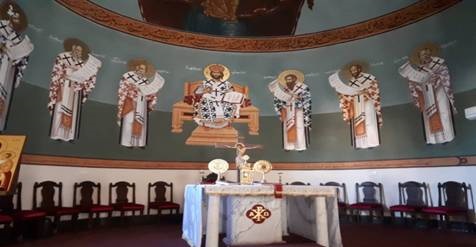Syria has been known throughout history as the cradle of Christianity and the center of the heavenly religions. Therefore, it is not surprising that there are dozens of the oldest and most famous churches in the world spread in a number of the Syrian provinces each of them tells the history and the origin of the first Christianity. What is strange is that these religious edifices were burned and destroyed during the years of the crisis and a thousand-year-old civilization was stolen by an ignorant ideology of armed Takfiri groups that has turned the places of worship into headquarters for its members and leaders and platforms to fire rockets and mortars at the safe neighborhoods.
The Cathedral of “Our Lady of Peace” at Bustan Al-Diwan neighborhood has not been excluded from the shells of hatred and treachery that aimed to destruct all the monuments and religious sites as it represents the cultural heritage of Syria, the cradle of the first civilization, from which Christianity has spread to all parts of the world.
 To shed light on the Church of “Our Lady of Peace” and its cultural and religious heritage, the Syria Time e-newspaper met Father Abdullah Qamz, Priest of “Our Lady of Peace” Cathedral for Melkite Catholics in Homs, who said: ” The church was built in 1970 in a western style under the supervision of Italian engineers. A number of icons and murals were introduced in 1986-1987 to “show the oriental features of the church. So although it is not an old church, it is the largest and the most distinguished church in Homs due to its a architectural style”.
To shed light on the Church of “Our Lady of Peace” and its cultural and religious heritage, the Syria Time e-newspaper met Father Abdullah Qamz, Priest of “Our Lady of Peace” Cathedral for Melkite Catholics in Homs, who said: ” The church was built in 1970 in a western style under the supervision of Italian engineers. A number of icons and murals were introduced in 1986-1987 to “show the oriental features of the church. So although it is not an old church, it is the largest and the most distinguished church in Homs due to its a architectural style”.
“The Church has its own facilities, which include: the Archdiocese and the Office of the High Priest Fathers, in addition to a church hall, which is built just under the church and is also one of the largest among the church halls in Homs.” He added..
Church and War
Father Qamz clarified: “The church has been occupied by terrorists for two years. They destroyed the church from the inside, burned the chairs for heating and removed the marble and tiles from the courtyard. They destroyed every beautiful thing inside the church since they are the enemies of truth, justice and beauty. They had hidden an explosive device weighing 200 kg TNT inside the church hall that exploded two days after the liberation of the area. The explosion was so violent that it caused major cracks in the walls of the church and severely damaged its infrastructure”.
Restoration and rehabilitation
To revive the Church and remove the consequences of terrorism, we had two choices, either to destroy the church and rebuild it again or to rehabilitate the affected parts of the church according to the current situation. Thus, our decisive decision was to do up this church because of the symbolism it enjoys in the whole governorate. So we started a comprehensive restoration process for almost four years with the help of a number of church institutions, other churches, brilliant artists and a number of expatriates. We have so far completed about 95% of the restoration work inside the church, Father Qamz concluded”.
 Artist Ayman Bitar was one of those creative painters who played an important role in the restoration of the icons that were badly damaged during the explosion.
Artist Ayman Bitar was one of those creative painters who played an important role in the restoration of the icons that were badly damaged during the explosion.
In a statement to the Syria times, Bitar stressed: “I was asked to fulfill a comprehensive study about the condition of the church walls, which were previously painted before the destruction and the explosion that took place inside the church and to save what could be saved through restoration and painting in the places where the murals were damaged… The first stage of my work began with the restoration of the upper part of the western wall inside the structure, which contains the icon of the Virgin, which was heavily damaged by the explosion.
The work on this icon continued for about a month and finally, I was able, thank God, to restore the icon to life again.
Bitar went on to say: “In the second phase, I worked on rehabilitating the lower part of the western wall inside the Church, under the icon of the Virgin. In the following phases a number of paintings had to be made, including the external facade of the church, restoration and painting of the Byzantine decoration on the pillars of the church and the Holy Trinity icon on the northern dome of the church. The work continues and there are still places in the church that need to be restored.”
No matter how brutal the enemies are, we will not be defeated and Syria will remain the land of peace, love and coexistence as it has always been through the ages.
Interviewed by Amal Farhat
Photos by Amal Farhat

